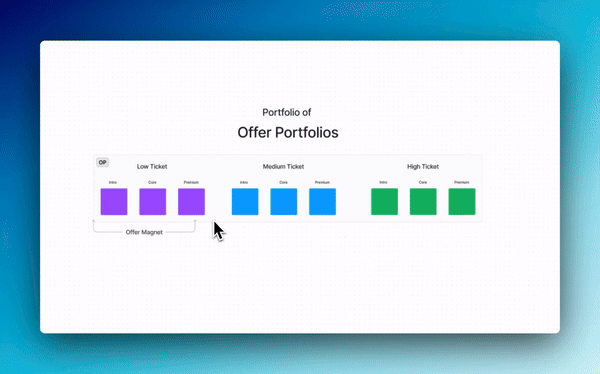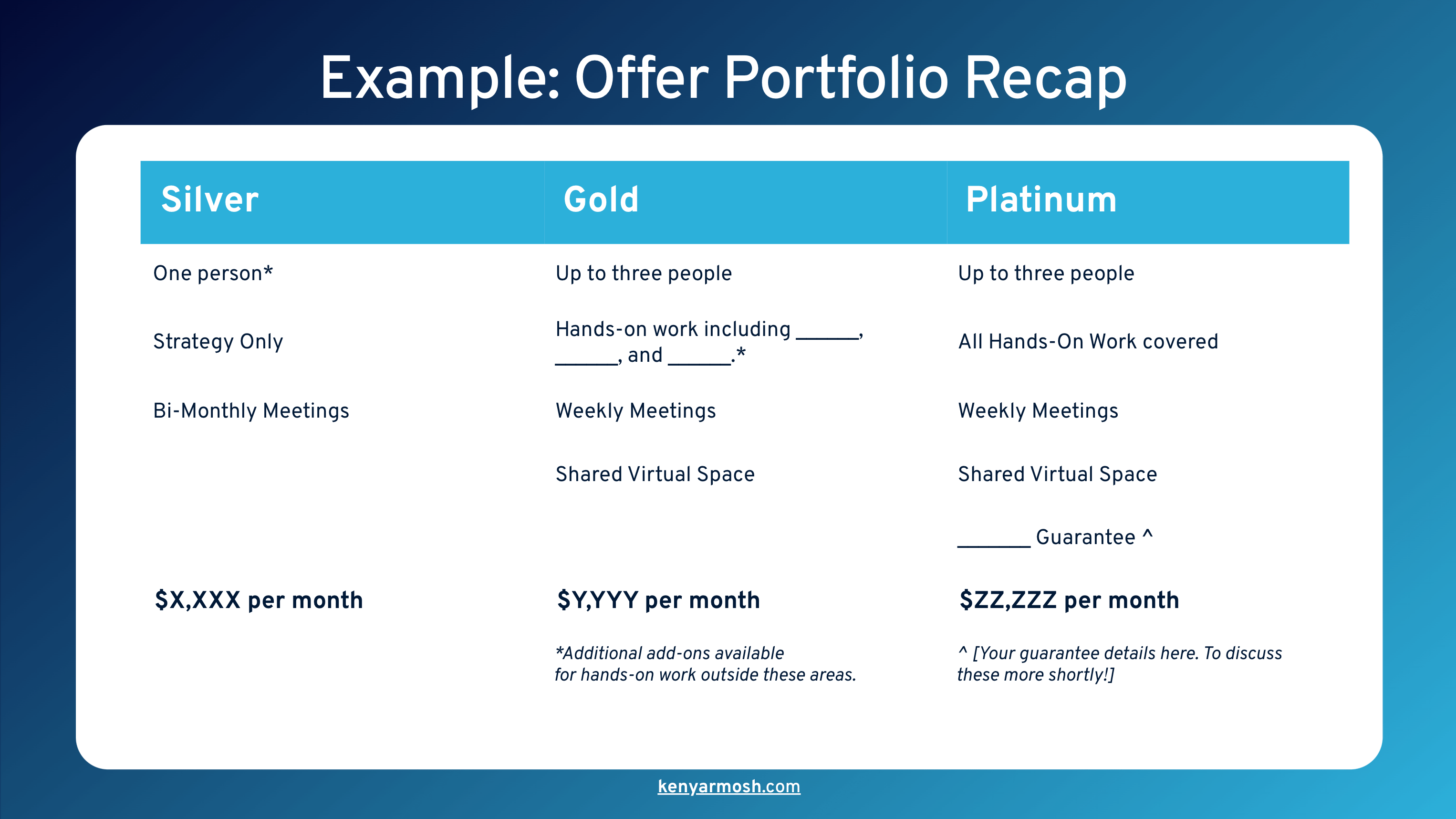🚀 TL;DR
- Experts often overshare details and overwhelm prospects — packaging expertise into clear, outcome-based offers makes it easier for clients to say yes.
- Sell outcomes, not tasks. Clients value specific results, not hours or deliverables.
- Build repeatable frameworks and signature offers with defined names, outcomes, and timelines — this creates authority, clarity, and consistency.
- Use naming, framing, and bundling to elevate perceived value; structure offers to encourage recurring revenue and logical client progression.
- The problem isn’t your expertise — it’s that buyers can’t understand or visualize what they’re purchasing. Simplify the packaging, not the value.
I've closed hundreds of deals over two decades. Built a $5M agency. Scaled multiple seven-figure businesses.
So, I know the moment my expertise works against me.
Picture this: You're on a sales call with a prospect who needs exactly what you offer. Yet when you started explaining my approach, you watched their eyes glaze over.
Because you were drowning them in depth they don't need yet.
That's the expert's paradox. The more you know, the more you want to share. You've spent years developing a nuanced understanding, sophisticated frameworks, and layered approaches. So when a client asks what you do, you give them everything.
And everything is overwhelming.
In this guide, I'm going to show you exactly how to take what you know and turn it into service packages that clients actually understand, value, and buy.
1. Turn your expertise into outcomes, not tasks
Selling tasks caps your earning potential. When you sell "I'll audit your systems" or "I'll redesign your website," clients pay for inputs. They're betting on your time and deliverables without understanding what life looks like after you're done.
Selling outcomes flips this. Instead of "I'll audit your sales process," you say:
"I'll identify the three bottlenecks killing your conversion rate and give you a roadmap to fix them in 30 days."
Clients struggle to value expertise because it's abstract. But they instantly value a specific result.
This positioning helps ideal clients self-identify and makes your pricing defensible. You're not charging for hours—you're charging for measurable outcomes.
2. Package the transformation
Packaging means creating a repeatable framework that delivers consistent results while allowing for client-specific nuance.
Here's what it looks like:
- Identify the core problem you solve repeatedly.
- Break your solution into a structured process with clear phases, defined deliverables, and predictable timelines.
- The structure stays consistent, but what varies is how you apply it to each client's context.
For example, I use Document → Template → Automate for my business and every consultant I work with. The framework doesn't change. But implementation with a financial advisor looks different from that with a marketing consultant, but the structure is identical.

When your knowledge is packaged into a repeatable service, you stop starting from zero with every client.
Your sales conversations become more efficient because you're describing a proven system.
Your delivery becomes faster because you're following established workflows.
3. Create signature offers that feel "ready to buy"
Most consultants cobble together a proposal for each prospect. They customize the scope, adjust deliverables, and create one-off pricing. Every deal feels like starting over.
But signature offers change this completely.
When I mention my Scalable Service Offers framework or Lighthouse Client methodology, people know exactly what I'm talking about. These aren't just services—they're assets that exist independently of any single engagement.
Your signature offer should feel like a product clients can buy, not a service they need to spec out. Give it a descriptive name. Define what's included and what's not. Establish a standardized timeline.
Ultimately, your perceived authority increases because you're demonstrating intellectual property.
Your pricing becomes defensible because you offer a fixed package at a defined price.
4. Use naming and framing to create perceived value
McDonald's didn't invent the hamburger. But they did invent the Extra Value Meal—bundling burgers, fries, and drinks under one name. That packaging innovation changed fast food economics.
Customers perceived more value in the bundle than buying items separately, even at identical prices.
Your service packages work the same way.
Generic names like "Consulting Package" make your work sound commoditized.
Specific names like "The LinkedIn Pipeline Builder" create their own category. Your prospects can't comparison shop because you're the only one selling that particular thing.
Beyond naming, framing matters. When you bundle multiple components and present them as one cohesive offer, clients perceive more value than if you list each piece separately.
Present three services at $2K each, and clients balk at $6K. But if you bundle them into one package for $6K, it feels reasonable.
5. Add layers that justify recurring revenue
Most service providers think recurring revenue means charging a monthly fee to "stay available." That's not recurring revenue—that's a monthly bill clients resent paying.
Real recurring revenue comes from ongoing value clients actively want to continue receiving. The difference is whether clients see continuous outcomes or just continuous access.
After delivering your core service, build in periodic optimization. For example, "Monthly conversion analysis with three tactical recommendations" is recurring value.
Or create staged rollouts where initial results lead naturally to next-level implementations. You're not inventing new work to justify a retainer. You're progressing through a planned sequence that builds on previous phases.
Design this intentionally from the start. Your initial offer should naturally lead to continued engagement because your work creates opportunities for refinement and optimization.

6. Use offer structure to escape price anchoring
Price anchoring keeps most service providers trapped in commodity pricing. When you sell hours or generic deliverables, clients anchor your value to whatever they paid someone else for similar work.
You break free from those comparisons when you package services into distinct offers.
If you sell "marketing consulting" at $200/hour, every client compares you to every other marketing consultant. If you're selling "The LinkedIn Client Acquisition System—a 12-week program that generates 15 qualified calls through content and outreach," what are they comparing you to? Nothing.
The psychological shift happens because clients evaluate your offer in isolation rather than against a mental benchmark. They're not thinking "Is this worth X per hour?" They're thinking, "Will this solve my $100K problem?" Totally different calculation.
7. Stack smaller offers into a value ladder
Most solopreneurs create one core service and wonder why they hustle for new clients. They're selling singular transactions instead of building relationships that expand over time.
A value ladder creates natural progressions where one offer leads logically to the next. Start with an accessible entry offer. For example, a diagnostic, strategy session, or focused workshop costs $500-$2,000. Something that makes it easy for ideal clients to start working with you without significant risk.

That initial engagement delivers real value while naturally revealing opportunities for deeper work.
Your core offer ($5K-$25K) becomes the obvious next step for clients who get results. Then you have ongoing optimization or advanced implementation ($3K-$10K/month recurring) for clients who want to keep building.
Each step delivers standalone value, creating a pathway from first contact to long-term partnership. Instead of constantly chasing new clients, you generate revenue by helping existing clients progress to higher-value offers.

You don't need more expertise—you need better packaging
You've spent years developing your expertise. You've solved problems, refined your approach, and built frameworks that create real results. That's not the issue.
The issue is making it easy for clients to buy what you're selling.
You're not dumbing down your work when you transform your expertise into structured service packages with clear outcomes, defined timelines, and compelling names. You're making it accessible. You're removing the friction between "I need help" and "Let's work together."
Every struggling consultant I've worked with had the expertise to succeed. What they lacked was the packaging that made their expertise buyable.
Your knowledge is valuable. Now make it visible, tangible, and easy to say yes to.
That's when clients stop going quiet and start reaching for their credit cards.

